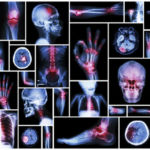Recent Research Published with Community Support
Several members of the hypermobile community responded to the calls for data before July 2023 to collect saliva as DNA samples to be shared and categorized by the scientists at the Medical University of South Carolina (MUSC). The MUSC Norris Lab thanks the many patients suffering from hEDS who submitted samples, which led to some key study findings published this May in honor of EDS Awareness Month. While many in the EDS community still await the publication of a gene for hypermobile EDS gene(s), which could one day lead to a potential blood test and reduce the long diagnostic journey, they shared a few other key findings from the data. Here’s what they learned…
A summary of the study’s top five findings is outlined below in ‘scientist-speak’ with some explanations so the rest of us can better understand the results and its implications.
- Participant Data, Demographics and Clinical Information
The study included a cohort of 2149 participants with clinically diagnosed hypermobile Ehlers-Danlos syndrome (hEDS), with a majority of participants identifying as female (91.53%) and an average age of 37 years. Approximately 76% reported a family history of hEDS. The participants provided self-reported clinical information, and their phenotypic presentations and comorbid conditions were categorized under seven medical specialties: orthopedics, dermatology, internal medicine, cardiology, neurology/neurosurgery, immunology, and psychiatry.
- Data and Cluster Analysis
In layman’s terms, the study on hEDS identified three different groups or clusters within the group of patients. These clusters showed significant differences in the types and number of additional health conditions (multimorbidity) that the patients experienced alongside hEDS.
First, to understand the terms used here, comorbidity refers to the co-occurrence of additional health conditions alongside a primary condition, while multimorbidity refers to the presence of multiple chronic conditions within the same individual. Both concepts highlight the complexity of managing and treating patients with multiple health issues and are important considerations in healthcare and medical research.
This means that even though all the patients had hEDS, they could be divided into three distinct groups based on the other health issues they were facing. For example, one group might have more severe symptoms, or a larger number of additional health conditions compared to another group. This finding officially states in a medical journal that hEDS is not the same for everyone and that there are different patterns of health issues that can occur alongside hEDS. The value in that is in understanding these different patterns can help doctors and researchers develop better ways to diagnose and treat hEDS. It also highlights the importance of considering the various health conditions that can accompany hEDS when providing care for patients.
- Prevalence of Clinical Characteristics
Participants in the study had an average reported Beighton score of seven (7) across all genders and age groups. On average, participants reported 11 different conditions, and 98.6% of patients had at least 4 comorbid conditions. The study did not observe a correlation between the Beighton score and the number of comorbid conditions reported by the patients, gender, or age. The study also revealed that the prevalence of autism spectrum disorder was twice as high in males compared to females and nearly 5 times higher in nonbinary individuals which is an interesting finding for potential future research. - Phenotypes and Comorbid Conditions
The study categorized diagnostic phenotypes and comorbid conditions commonly seen under the seven various medical specialties outlined above. “Phenotype” refers to an observable trait. “Pheno” simply means “observe” and comes from the same root as the word “phenomenon”. And so it’s an observable type of an organism, and it can refer to anything from a common trait, such as height or hair color, to presence or absence of a disease. The most-reported diagnostic phenotypes among female participants in the cohort included chronic pain, joint subluxations, abnormal scarring, stretchy skin, poor wound healing, and joint dislocations. Valvular heart disease, abdominal hernias, and pelvic organ prolapse were also prevalent in the cohort. - Clinical Implications and Conclusion
The study’s findings provide fresh insights into the clinical spectrum of hEDS, underscore the presence of multimorbidity within the cohort, and emphasize the importance of considering these clinical associations in research, cross-screening, and patient care. The capacity to group patients with hEDS into subclusters based on their clinical phenotypes suggests potential divergent genetic and/or environmental influences. Identifying these subclusters can empower physicians with innovative clinical approaches and the possibility of predictive diagnostic tools. The study also emphasizes the essential collaboration among physician specialists, patients, and researchers to break down the barriers of siloed health care for this patient population.
The study acknowledges limitations related to self-reported surveys, including recall bias and selection bias. Additionally, the study recorded gender identity but not biological sex, and the average age of participants included children as young as 13 years. Health disparities and limited access to care pose additional challenges, and the percentages of patients with specific comorbidities are likely conservative estimates. Despite these limitations, the study provides novel insights into the clinical presentation and multimorbidity in hEDS and can serve as a guide for clinical care and future research studies.
Additional Key Finding: Beighton Score Needs Work to Accurately Diagnose hEDS
The study also suggests several implications for the diagnostic criteria of hEDS based on the findings and analyses, which suggest the following considerations for the 2017 diagnostic criteria:
- Expanding the Diagnostic Criteria Needed
The study indicates that hEDS often presents with symptoms that go beyond the current diagnostic criteria. Patients may present with functional disorders of the gut-brain axis, sleep disturbances, anxiety, depression, fatigue, dysautonomia, mast cell activation syndrome (MCAS), and spinal instabilities, which are not fully captured by the existing diagnostic criteria. - Comprehensive Clinical Findings
The study emphasizes the need for more comprehensive clinical findings in patients with hEDS. It suggests that the 2017 diagnostic criteria may not fully capture the full spectrum of hEDS manifestations, calling for further research to refine the diagnostic guidelines and expand the criteria to encompass a broader range of symptoms and conditions commonly associated with hEDS. - Incorporating Multimorbidity
The study highlights the importance of considering multimorbidity in hEDS. It suggests that traditional diagnostic approaches may not fully capture the diversity within the hEDS population, especially when considering comorbid conditions. The identification of distinct clusters within the patient cohort with hEDS, based on the prevalence of comorbid conditions and diagnostic phenotypes, indicates the need to revise and expand the diagnostic criteria to better reflect the clinical diversity observed in patients with hEDS. - Challenges with Beighton Score
The study explores the relationship between the extent of generalized joint hypermobility (GJH) as evaluated by the Beighton score and specific clinical manifestations. However, integrating Beighton scores into the clustering analysis resulted in the dissolution of the established clusters, suggesting that GJH may not necessarily align with disease presentation. This observation indicates that the Beighton score may not be the most reliable tool for predicting patient phenotypes, raising questions about its utility in the diagnostic criteria for hEDS. - Need for Revision of Clinical Guidelines
Leveraging data from the largest cross-sectional clinical hEDS registry to date, the study suggests that the revision of clinical guidelines for diagnosing patients with hEDS based on these data sets should now be considered. The adoption of multidisciplinary and well-coordinated approaches is proposed for improving screening, diagnosis, and treatment, with the aim of reducing the burden on the healthcare system and enhancing patient outcomes.
In summary, the study (full text) supported by Mayo and many community members, has provided valuable insights into the clinical spectrum, multimorbidity, and distinct patient subgroups within the hEDS cohort. These findings have important implications for clinical care, research, and the understanding of hEDS as a complex condition. The study also suggests that the diagnostic criteria for hEDS should be expanded to encompass a broader range of symptoms, conditions, and multimorbidity profiles commonly observed in patients with hEDS. It also emphasizes the need for a more comprehensive and multidisciplinary approach to diagnosis and management, taking into account the diverse clinical manifestations and multimorbidity associated with hEDS.
Thank you to all the cohort participant members, researchers, writers and supporters of the study for sharing the findings to better support the hEDS patient community in someday finding answers faster.


